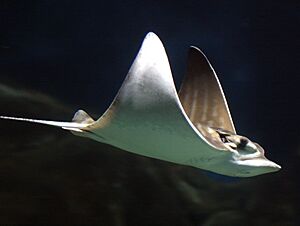Bull ray facts for kids
Quick facts for kids Bull ray |
|
|---|---|
 |
|
| Conservation status | |
| Scientific classification | |
| Synonyms | |
|
Pteromylaeus bovinus Geoffroy Saint-Hilaire, 1817 |
The Aetomylaeus bovinus, often called the bull ray, is a very large stingray. It's also known as the duckbill ray because of its unique snout. These rays live near the coasts of Europe and Africa.
Contents
About the Bull Ray
Life and Growth
Bull rays are born from eggs that hatch inside the mother's body. This is called ovoviviparous. They become adults when they are about 4 to 6 years old. Female bull rays usually have only three to four pups at a time. Their pregnancy lasts a long time, from 6 to 12 months. This slow reproduction makes them very sensitive to threats.
These rays are true giants of the shallow ocean. They can grow very wide, up to 2.22 meters (about 7 feet) from wingtip to wingtip. They can also be 1.5 meters (about 5 feet) long and weigh as much as 116 kilograms (about 255 pounds)! Their large size and love for shallow waters (from the surface down to 30 meters or 100 feet) make them easy targets for dangers. Female bull rays are usually bigger and heavier than males.
What's in a Name?
This fish is called the bull ray because its head looks a bit like a bull's snout. In South Africa, people sometimes call it the duckbill ray. This is because of its long, flat, and rounded snout, which looks like a duck's bill.
What They Eat
Bull rays are "bentho-pelagic" feeders. This means they find food both on the sea floor and in the water above it. They eat many different small sea creatures. Their diet includes crabs, hermit crabs, squids, prawns, and different types of snails and clams. Sometimes, they can cause problems for clam and oyster farms because they dig up the seabed to find food.
Why Bull Rays Are in Danger
Main Threats
The bull ray faces many dangers, mostly from fishing and damage to their homes. Since they feed near the bottom and in the middle of the water, they often get caught by accident. This is called by-catch. They are caught in many types of fishing nets, like trawling nets, bottom trawling nets, trammel nets, and gill nets. Even spearfishing can harm them.
In the past, a lot of bull rays were caught by accident. For example, in 1988, shrimp boats on the West African coast accidentally caught about 900 tons of young and adult bull rays in just one year.
Protecting Bull Rays
Conservation Status
Globally, the bull ray is listed as Critically Endangered. This means they are at a very high risk of disappearing forever. In the Mediterranean Sea, more than half of the ray and shark species are in danger of extinction. The bull ray population in the Mediterranean is thought to have dropped by 80% in the last 45 years.
What Needs to Be Done
Right now, there are no special rules just for protecting bull rays. We need to learn much more about them. Scientists need to study how many bull rays there are, where they live, what they do, and what threatens them. To help them survive, we need to:
- Protect their habitats (the places where they live).
- Keep track of how many are caught and manage fishing better.
- Teach people about bull rays and why they are important.
Where Bull Rays Live
Their Home Range
We don't know the exact full range of the bull ray, but they are found in several places. They live in the Mediterranean Sea and the Black Sea. You can also find them in the eastern Atlantic Ocean, from Portugal down to Guinea. In southern Africa, they live along the Atlantic coast near Saldanha Bay and around to the Indian Ocean coast, up to Maputo Bay in southern Mozambique. They have also been seen near Zanzibar and Kenya.
Preferred Habitat
Bull rays usually live in shallow waters. They are found from the area where waves break (the surf zone) down to depths of 65 meters (about 213 feet) or more. They also swim into estuaries (where rivers meet the sea) and lagoons. They can be found both on the sea bottom and near the surface. Sometimes, they even leap out of the water!
Like many other rays in their family, bull rays might travel long distances. However, we still need to learn more about their movements and how their populations change over time.


